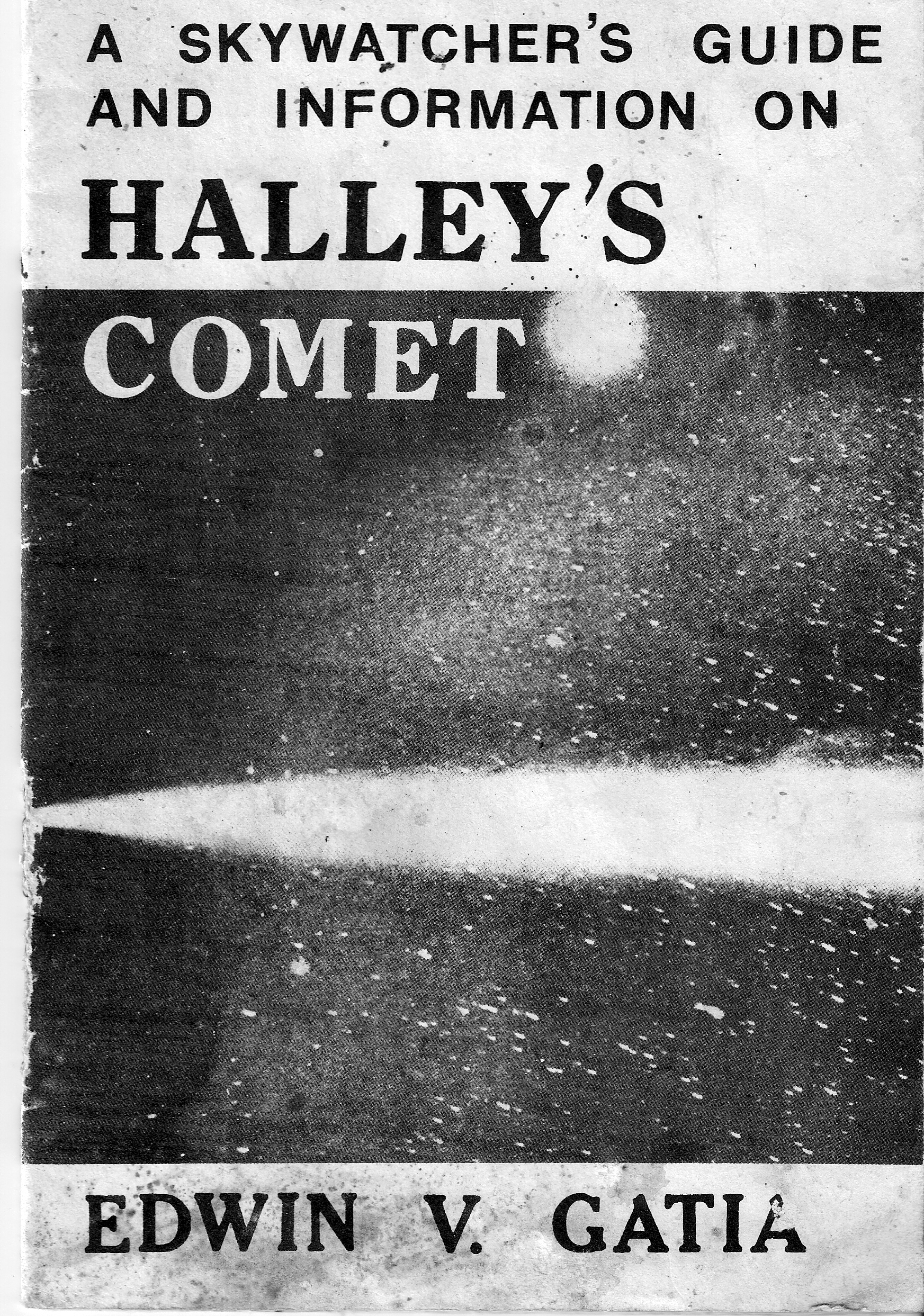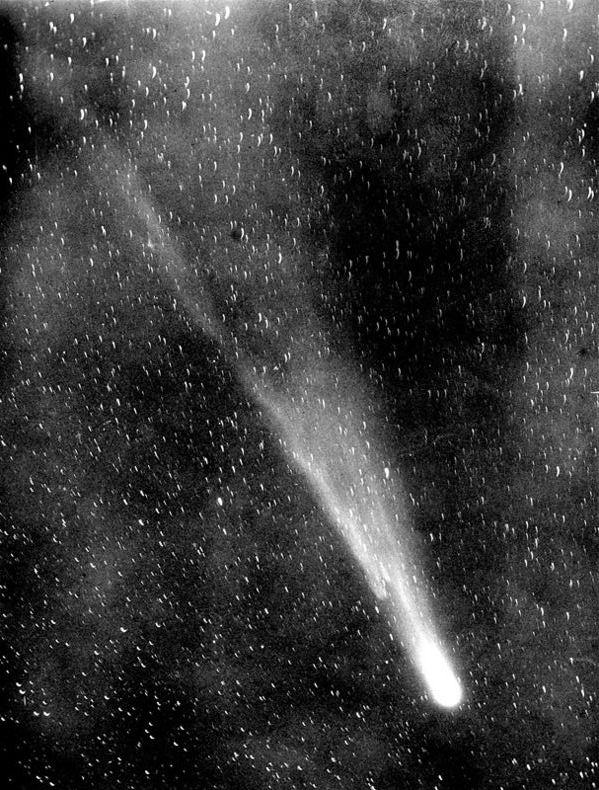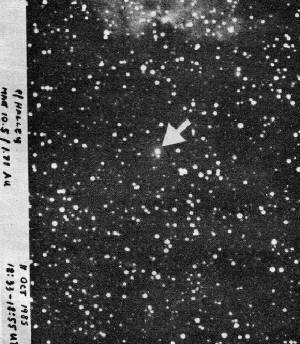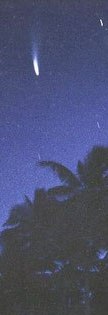|
" . . . Now, many things lead me to believe that the
comet of the year 1531, seen by Apian, is the same
as that which, in the year 1607, was observed by Kepler. . .
and now which I saw and observed myself at its return
in this year 1682. . . '
- Sir Edmond Halley
 Those who were born in 1985 will have to wait for the next 75 years- (or around the
year 2060), to see Halley's Comet, for it was in 1985 that the famous Comet that bears the name of an
English Astronomer-Royale, the great Edmund Halley, made its last apparition in our skies. While Comet
Halley- one of the longest of the periodic comets, has been observed long before the days of Halley, it was him who discovered
the comet's regular return to the sun once every 75 or 76 years.
My dad was only 10 years of age when Halley's Comet previously
appeared in the skies in 1910, and he lived to see the comet again in 1985. It's scheduled return to the vicinity of
the sun was well expected by the astronomical world that preparations for scientific observations had been meticulously made
well in advance- including the worldwide collaboration of both amateurs and professionals in the International
Halley Watch (IHW) Program under the auspices of the Jet Propulsion Laboratory,
NASA, headed by Dr. Stephen Edberg.

Indeed, its return in 1985-86 marked a rare opportunity for the astronomical world
to make detailed, accurate, and comprehensive study, and in order to coordinate all studies conducted on the comet, the
IHW was thus organized composed of several Specialist-Teams whose operational objectives included, among others, the standardization
of useful observational techniques, promotion of simultaneous observations, and to organize closely spaced-time sequenced
obserations in the duration of the apparition.
Halley's Comet (photo, left) as it appeared in the early part of the summer of 1986
(NASA).
Discovery of the Comet
Named after the astronomer-royale who predicted its return
in the year 1758, Halley's Comet- though not necessarily the brightest, but is the only bright comet which has a
period of revolution of less than a hundred years. Its earliest recorded appearance was around the year 240 BC,
but may possibly have been seen and recorded as far back as the year 466 BC.
Armed with mathematical calculations carried out by Flamsteed,
Halley was so convinced of his belief that the comet he was observing in 1682 would return in 1758. When the year came,
the astronomical world was in frenzy for the search of the returning comet, but as fate would have it, the luck of discovering
the return of Halley's Comet fell on a German farmer and AMATEUR ASTRONOMER, Johann Palitzsh,
who recovered the comet on the eve of Christmas Day, 1758- the year that Halley predicted its return. Unfortunately,
Halley did not live to see the return of his comet for he has passed away only 17 years earlier.
On its last visit in 1910, Comet Halley was recovered photographically
at Heidelberg Observatory by Max Wolf. It may also be interesting to note, in passing, that a bright comet also appeared
in 1910, but its appearance was largely ignored since everyone has been looking forward to seeing Halley's Comet that same
year.
For its return in 1985, our own fellow Filipino amateur also
was able to image the comet in November of 1985.
|

Halley Captured at Stardust Observatory
An ardent amateur and member of the PAS became the first Filipino to image
Comet Halley, at the time when the comet appeared lik a diffused blob of light at magnitude 10.3 from a distance of about
1.71 AU as it approached the sun from its location between the orbits of Mars and Jupiter.
Amateur astronomer JOHN L. NASSR at his Stardust Observatory in
Baguio City, operating an 8-inch Schmidt camera f/1.5 with a focal length of 300-mm loaded with
Technical Pan 2415 film (hypered in hydrogen-nitrogen gases for 3 days at 90-deg F and developed in
D76 at 68-deg F for 10 minutes), had exposed the film for about 22 minutes.
Photography of the comet was made at 1833H to 1855 UT, when the comet was then
in the constellation Orion- just a few minutes of arc from NGC-2174.
|
A team of astronomers led by a 24-year old British graduate
student- David C. Jewitt, caught a dim point of light on photographic plates on the night of 15-16 October, 1982. With
colleague G. Edward Danielson, D. Jewitt took five 480-second exposures on the night of 15-October, and on October 19, astronomers
at Caltech confirmed that the dim spot of light they have detected using a special camera attached to the 200-inch Hale Telescope
at Palomar Observatory, was indeed that of Halley's Comet on its approach toward the sun.
Several astronomers from various Observatories have been
trying to "recover" the "Comet", but the discovery of Jewitt and Danielson had "put an end" to an "unofficial, unacknowledged,
but nonetheless fierce competition for the search that has began as early 5 years before.
At the time when Halley's Comet was photographed, it appeared
as a tiny dot with a stellar magnitude of about + 24.2 and moving to the southwest in the constellation Canis Minor at
an estimated distance of about 11.0 AU from the sun- well outside the orbit of Saturn, and was "as faint as the
light from a single candle seen 27,000 miles away!"
The recovery of Halley's Comet was made possible mainly- among
other things, the precise mathematical calculations carried out based on the regularity of its orbital period that it appeared
in the photograph within 10-seconds of arc of its predicted position in space, and a "mere 10 hours behind schedule!"
The IHW and the Role of the Amateurs.
From the very beginning, organizers of the IHW have come to realize and recognize
the potentials of skywatchers and amateur astronomers and the valuable scientific data they could possibly contribute
to the Program. In view of the large number of amateurs on a global scale, weather interference on observations would
be brought to the minimum while at the same time, geographic coverage wold be more comprehensive than would otherwise the
case be if only a select few professionals are involved.
Perhaps the most important aspect which gave the amateur a better advantage over
the professionals is the fact that amateurs own their own equipment and instruments, and are not therefore constrained by
telescope-time allotments or other duties that limit the time of participation of professionals. Finally, there are
some observations of Halley's Comet and related phenomenoa which are simply more easily done by amateur astronomers, and a
more comprehensive coverage is possible with their assistance and involvement.
At the time, several areas of study have been identified to which amateurs can
make significant contributions which, among others, include: visual observations; photography; astrometry; spectroscopy; photo-electric
photometry; and related meteor studies. Incidentally, I remember that the Program was practically open to the members
of the general public- whether or not you owned an instrument at all.
In The Philippines . . .
In the Philippines, the Philippine Astronomical Society also created
its own local version- the Halley Watch Committee of the Philippines (HWCP) with Imelda
B. Joson as National Recorder. Members of the Committee included the following: Edwin L. Aguirre;
Dante L. Ambrosio; Victor L. Badillo, SJ,; Elmer Bringas, Jr; Jose
G. Caburian;; Mandy R. Dinglasan; Edwin V. Gatia; George S. Goyena;
Alexander L. Lim; John L. Nassr; Michael C. Nealega; Cesar I. Nunez;
Edward Quinto; Johnny Quinto; and Norman A. Salvanra. Consultants
were Atty. Isaac O. Chaves and the late Fr. Francis J. Heyden, SJ, of the Manila Observatory.
|
